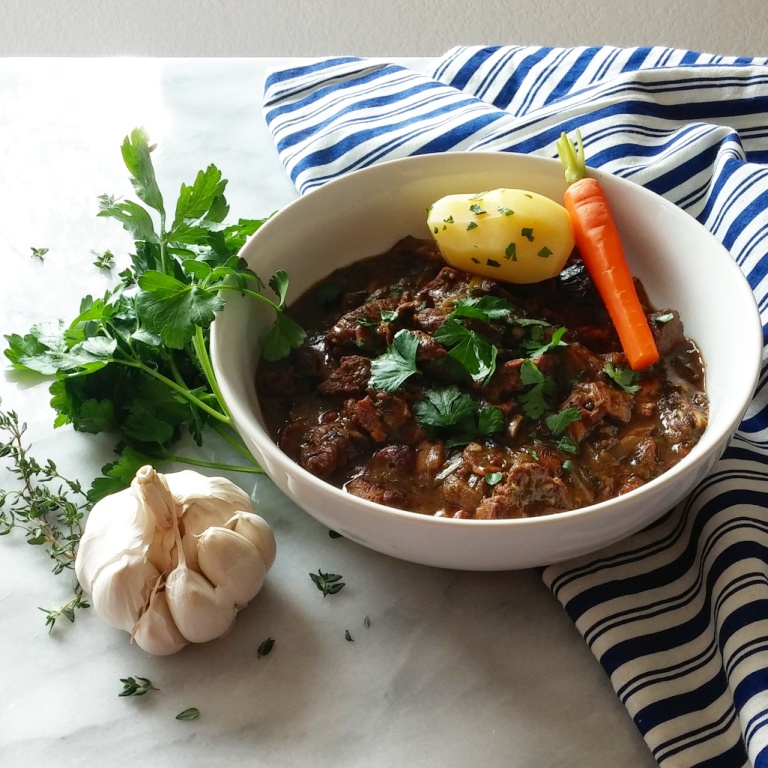Copyright by Jacqueline Peppard, all rights reserved.
A country Flemish woman deftly moves about her 17th century kitchen with hair tied up in a white woolen cap and blue muslin apron on. Braids of garlic, onions, and herbs are suspended from the rough hewn ceiling beams. Rays of late morning sun gently stream through a window and bounce against the white plaster walls, filling her eyes with golden reflections. Life is good this year. It is winter, but the bountiful summer harvest lines the cellar shelves with ceramic bottles of dark brown ale, sides of smoked pork, and baskets of root vegetables. She creates a stew for the mid-day meal, a recipe containing beef, bacon, onions, beer, dried herbs, and root vegetables – Beef Carbonnade. A savory aroma soon wafts throughout the house warming the heart and beckoning one to the table.
Spring is almost here, but most can’t even begin a garden of hardy greens yet. In countries still receiving snow, a Paleolithic hunter and gatherer’s food supply would be restricted to whatever wild game he could kill. Much of the ground would still be frozen, and any plant food like greens and root vegetables just wouldn’t be on the menu yet. A denizen of the 17th century would be running low on veggies and would be limited to properly stored root and tuber vegetables that mice or rats hadn’t raided. Any wild game would be stretched with pork raised and cured from the prior summer. Our early ancestors available winter food supplies gave birth to the dish also known as Carbonnade Flamande.
The gourmet name disguises the humble nature of the dish, a sweet-sour beef stew largely comprised of onions. Unlike Beef Bourguignon made with wine, it is distinguished by the rich earthy flavor of dark ale contrasted against onions and herbs. My interpretation calls for 4 different members of the allium family, each adding its own individual flavor to the mix, balsamic instead of apple cider vinegar, and LOTS of bacon. Root vegetables are typically boiled and served on the side.
Tools:
SERVES 4
Ingredients:
1 lb. beef stew meat, cut into 2 inch cubes
Butter
Thick bacon, cut into 1/2 inch pieces
Garlic cloves, diced
Large leek, cut in half, rinsed, and cut into 1 inch pieces
Shallots sliced lengthwise
Large yellow onion sliced lengthwise
Dark Ale (gluten free if possible)
Balsamic vinegar
Fresh thyme (about 1/4 cup trimmed and chopped)
Fresh tarragon (about 1/8 cup trimmed and chopped)
Fresh parsley (about 1/8 cup trimmed and chopped)
Salt and coarse ground black pepper, to taste
Like what you see? The full recipe is now only available in my New Era Healthy Eating Cookbook. Here is the link to check out the cookbook. If you had been an early subscriber, you would have received this recipe long ago when I was first developing it. Sign up and then you never miss out on exclusive recipes delivered directly to your email box, or private Q&A’s, giveaways, blog post notices, and more! There is no cost to join.
Most likely many of you are viewing peeled and boiled vegetables, including beer to boot, as heretical in relation to modern day healthy eating practices. However, our ancient ancestors understood the wisdom of these food preparation practices which have been lost to our modern world. Beer making, peeling, and boiling the vegetables does destroy many of the plant nutrients, however these preparation processes do provide the benefit of enhancing the bioavailability of the remaining nutrients. While raw vegetables definitely contain more nutrients, our bodies cannot process them, so many are lost and passed through our systems unused. Plants contain anti-nutrients that act as protective mechanisms against the animal world in the form of phytic acid, oxalates, tannins, trypsin inhibitors, enzyme inhibitors, lectins (hemagglutinins), protease inhibitors, gluten, alpha-amylase inhibitors and alkylresorcinols. These anti-nutrients prevent the uptake of vitamins and minerals, and inhibit the function of our organs, especially the thyroid.
The whole grain, leave the peel on, steam your veggies, low-fat health movement began at the turn of the 20th century, gained momentum in the 60’s and proceeded to steamroller through the 90’s, did not promote healthy principles. Most of the anti-nutrients lie in the skin of the vegetables or fruits and the outer bran layer of the grain. This makes sense given the skin is the first line of defense for plants. The process of soaking, germinating (sprouting) and then drying the grains to create the malt used in beer making processes enhances the bio-availability of the grain nutrients. Combine that with the fermentation process and you have food where most of the anti-nutrients are removed. Peeling and boiling vegetables accomplishes the same thing. Not only do we have the issue of anti-nutrients, but many of the vitamins such as A, D, E and K present in vegetables and fruit are fat soluble. Minerals present in plants work synergistically with the fat soluble vitamins and are biologically unavailable to our bodies for absorption without the presence of readily available and proportionally correct omega 3’s found in animal fat.
For a comprehensive discussion on plant anti-nutrients and the effects of traditional food preparation on these, check out the article on the Weston Price Foundation website, Plants Bite Back.
There is also another extremely informative article on this topic called Living with Phytic Acid.


I used the recipe for Carbonnade – Beef, Bacon, Beer & Onions, all of my husbands favorites, exactly as listed including the Cook’s Notes to prepare the vegetables separately which was good because that kept the potatoes and carrots firm. The end result was a delicious meal. We loved the broth and will do this one again. Thank you New Era Healthyeating for creating this recipe.
So happy you enjoyed the recipe! Thank you for taking the time to comment and your support 🙂